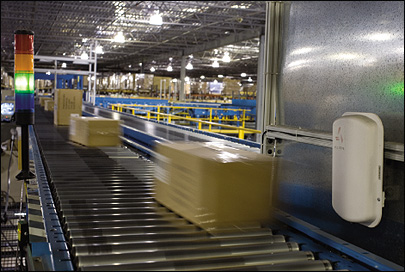The letter to the World Kitchen CEO from Wal-Mart was dated May 25, 2004. It said simply that Wal-Mart planned to deploy a new technology called radio frequency identification in its supply chain beginning in January 2005. Wal-Mart’s top 100 suppliers would be required to put RFID tags carrying Electronic Product Codes on pallets and cases by that time. The next-largest suppliers, which included World Kitchen, would have to start tagging products in January 2006.
The Wal-Mart letter was followed by one from Target on July 1, asking World Kitchen to start tagging pallets and cases even earlier—June 2005. World Kitchen had one year to learn how to comply with tagging requirements and deploy RFID technology in its supply chain. It met Target’s tagging requirements in June 2005 and Wal-Mart’s in January 2006. And it was among the first suppliers to integrate its RFID system with its back-end software, making it possible to increase the number of stock-keeping units (SKUs) tagged without increasing costs, and paving the way for the company to achieve internal efficiencies as the technology evolves and costs come down.
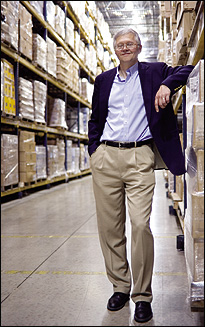
World Kitchen is less than a decade old. In 1998, Corning, a company well known for its CorningWare dishes and Corelle tableware, sold off its consumer products business. A year later, World Kitchen was formed when the former Corning unit was combined with two acquisitions—General Housewares and EKCO Housewares. Today, World Kitchen manufactures bakeware, dinnerware, kitchen and household tools, range-top cookware and cutlery. These are sold under well-known brands, including Baker’s Secret, Chicago Cutlery, Corelle, CorningWare, EKCO, Magnalite, OLFA, Pyrex, Revere and Visions.
The company sells its products through mass merchants, department stores, specialty retailers, retail food stores and its World Kitchen Web site. It has manufacturing operations in Asia and the United States, two distribution centers in the United States and one DC in Canada.
World Kitchen ships some 10 million cases to Wal-Mart and 3 million cases to Target annually. So when the company received the letters about RFID tagging requirements, it set off a flurry of activity. Dan Hogan, senior vice president of operations, launched a steering committee consisting of World Kitchen CIO John Conklin, vice president for information technology Randy Peterson and director of distribution Tom Beyeler to research RFID technology and put together a project plan and timeline for how the company would respond to the retailers’ requirements.
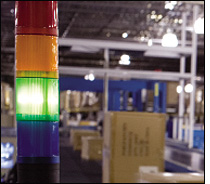
In July 2004, the steering committee set up a six-person team headed by Beyeler to work day to day on meeting the tagging requirements. There were three members from IT (Randy Peterson and two of his staff), two from DC operations and one from the Wal-Mart sales account team. The six began getting educated about RFID technology and the retailer mandates by attending conferences, including seminars for suppliers held by Wal-Mart and Target and an EPCglobal event.
The team members met with a variety of RFID hardware and software vendors that they thought might be able to help World Kitchen achieve its objectives. On Oct. 27, 2004, the steering committee made a presentation to senior management suggesting the company start tagging products at its Monee, Ill., distribution center. The Monee DC had opened in July 2000 and had the newest and best sortation system, and the RFID team felt that it would be easier to implement the process there first. (Both of the company’s distribution centers cover the whole United States, but they distribute different product lines.)
Another critical decision made up front was to integrate the tagging operation with the company’s back-end systems. This was not a common approach. Most suppliers were opting for a simple “slap-and-ship” system—putting the tags on the cases and pallets before shipping them to a customer and maintaining separate databases for RFID-tagged products.
“The decision to integrate the RFID tagging operation with the back-end system came out of team discussions,” says Peterson. “It was evident to us that we were going to be required to tag more SKUs over time, and we wanted to put a process in place that was very scalable, so we wouldn’t have to redo it as the number of SKUs tagged increased.”
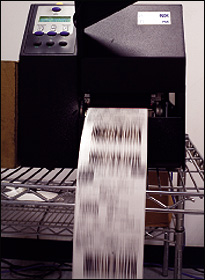
Another issue was cost. The committee was not anticipating that the company would achieve a return on its investment in the RFID system in the first few years, so they wanted to keep the costs as low as possible. With slap-and-ship systems, labor costs typically increase as the number of SKUs increases because separate databases of product information must be maintained and linked to EPCs. With an integrated system, product data can be linked automatically to EPCs quickly and efficiently. The only added cost is for the RFID tags.
Once the decisions were made to start tagging in the Monee DC and integrate the operation with the back-end systems, World Kitchen put out a request to several companies for proposals. Three companies responded. SAP submitted a plan to do the project jointly with Acsis, which provides enterprise software and services for automating manufacturing and supply chain processes. Acsis’ Data- Link Enterprise software provides integration of automatic identification devices with SAP’s enterprise resource planning (ERP) applications.
World Kitchen had deployed SAP’s R/3 ERP software in 1999 and implemented its warehouse management solution at the Monee facility in 2003. So in December, the steering committee chose the SAP-Acsis team for the RFID project. SAP and Acsis would deploy the RFID interrogators and label printer-encoders and integrate them with SAP’s Auto ID Infrastructure (AII) middleware, which would pull information from and transfer information to the SAP back-end systems.
There were several reasons why World Kitchen chose SAP and Acsis. Since World Kitchen used SAP software to run its business, using AII offered seamless integration between the RFID system and the back-end applications. Acsis offered one-stop shopping—it could supply and install the interrogators and integrate them with AII. And because Acsis’ Data-Link Enterpise software was one of the few device control solutions that was certified by SAP, there was less chance that the implementation would get bogged down with costly integration problems.
“We needed to implement the solution on a tight timetable,” says Peterson. “A vendor who could come in and install the hardware and middleware was an advantage to us. They’d also been in the market a while and had some other clients, so we felt they offered the ability to complete the project quickly and with little risk.”
The Project Plan
After SAP and Acsis were chosen as the prime technology partners on the project, World Kitchen sent samples of 15 SKUs that were reflective of its overall product line to Acsis’ test lab. Acsis placed Generation 1 Alien squiggle tags in various locations on each SKU and ran them past an interrogator on a conveyor going 600 feet per minute to determine the tag location likely to deliver the highest read rates when the products reached Wal-Mart and Target DCs.
“Using our testing facility, which simulated real-world conditions, we helped World Kitchen find the correct tag placement and configuration of the hardware to achieve tag reads,” says John Peery, the account manager for Acsis who worked on the World Kitchen implementation.
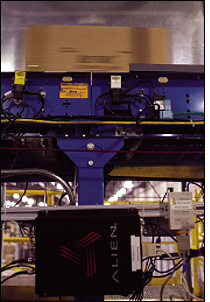
Meanwhile, World Kitchen’s RFID team began holding weekly meetings. Through the first quarter of 2005, they examined the DC operations and put together a plan for where cases should be tagged, how to link product data to the EPC and where the tags should be read internally. World Kitchen’s RFID team members also met with their counterparts at Target and Wal-Mart once every two or three months to keep them apprised of their progress.
The Monee DC is 700,200 square feet (to put that in perspective, 15 football fields would fit inside it), and it has 64,939 racks for storing pallets and 108 dock doors. When an order comes in from a retailer (typically via electronic data interchange), it goes into World Kitchen’s SAP order-management application, which allocates inventory to that order and creates what’s called a delivery (an electronic document that starts the process of picking the cases, packing them on a pallet and shipping them).
The contents of the order, date of shipment, shipping destination and staging area are sent to the SAP warehouse management application. A custom piece of software developed by World Kitchen takes information about the size of each case from a master data file, which stores all product information, and creates a plan for how the products should be stacked on each pallet.
The system generates labels and a pick list. Workers locate the cases, scan a bar code on the label with a handheld Intermec computer, and scan a bar code on the picked case to make sure it’s the correct case. If the bar codes match, the person applies the shipping label and places the case on a conveyor that is part of a high-speed sortation system. The case is routed to a specific staging area, where it is stacked on a pallet in the correct place.
The RFID team created a plan in which orders would be received from Target and Wal-Mart as they normally would. The order-management system would determine whether the shipping destination was an RFID-enabled DC. If it was, the warehouse management system would route the order information to SAP’s AII middleware, which would assign an EPC to each case by adding a unique serial number to the product’s standard Global Trade Identification Number (GTIN) and then send instructions to RFID label printer-encoders from Printronix, which were installed in the DC, where bar-code labels were already being printed.
The DC staff would retrieve the labels and pick the product the way they normally do. They would manually apply the label to the case in the location likely to achieve the highest read rates. The cases would then be placed on the sortation system. Two interrogators from Alien Technology would be set up along the 200-feet-per minute conveyor, at a point where several conveyors merge into two lanes. The tags would be read at that point to confirm that the right product was picked. The tags would be read again after the pallet had been stretch-wrapped.
“We didn’t change our processes for RFID,” says Partha Erra, operations manager for World Kitchen’s Monee facility. “We tried to make it as transparent as we could to people on the floor.”
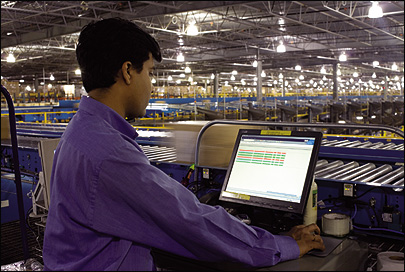
Deploying the System
In March 2005, the team held a two-day meeting in the Monee DC to go over the blueprint with two representatives from Acsis and one from SAP. The technology partners suggested some minor changes to the plan, but much of the meeting was spent mapping out the steps for how they would install the system without disrupting the DC’s operations.
In May 2005, SAP and Acsis installed a dedicated server in the DC to run SAP’s AII middleware and two interrogators over the conveyor system. Acsis linked the RFID interrogators to AII using its Data-Link Enterprise integration platform. SAP linked AII to the warehouse management system and interrogators. The installation took several days.
The team ran into one minor hardware issue. When the system was first installed, an interrogator on one conveyor often picked up a tag from a case on the neighboring conveyor. To solve the problem, Acsis turned down the power emitted by the interrogator antennas and placed an aluminum shield between the two conveyor belts, blocking the emission from antennas on the neighboring belt.
World Kitchen sent the first tagged shipment to Target on June 17, 2005, right on schedule. Beyeler’s team created a spreadsheet for Target that contained information on the 19 SKUs that would be tagged, including basic product information such as the Universal Product Code and GTIN.
“We coordinated with them so they would know when the first shipment would arrive and what would be in it,” says Peterson. “After the first shipment, we did a follow-up call and were told that 100 percent of the tags were read. We were lucky, because we don’t achieve that on every shipment, but we felt great about our initial success.”
World Kitchen completed the RFID project within budget. The $400,000 it had allocated through the launch in June 2005 covered its membership in EPCglobal, the initial purchase of hardware (interrogators and the first batch of labels), and the cost of software and service from SAP and Acsis.
The Future
This year, World Kitchen expects to ship about 100,000 tagged cases to Wal-Mart and Target, and is projecting it will ship as many as 2 million tagged cases in 2007. That’s because it has agreed to tag all its SKUs to Target’s RFID-enabled DC in Texas, and it will tag more SKUs for Wal-Mart as the retailer expands from five RFID-enabled DCs to 10 and from 500 stores to nearly 1,000 by the end of this year.
World Kitchen also will deploy an RFID tagging system at its Greencastle, Pa., distribution center, and it may need to deploy RFID in Canada, if Wal-Mart requires it.
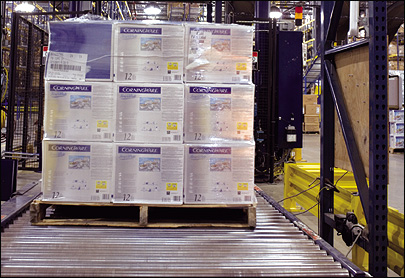
Peterson believes that having integrated RFID with its existing back-end systems puts World Kitchen in position to meet expanded tagging requirements from its retail partners. The incremental cost of the RFID tags is the only cost associated with tagging more SKUs. While other companies will have to employ more people to operate more tagging stations, World Kitchen can simply go into the SAP order-management system and indicate which additional SKUs are being tagged and which customer DCs are accepting tagged items. When orders come in, the integrated system will take care of the rest.
The tags are an added cost for World Kitchen, but that cost is falling. In 2005, the company paid 53 cents per unit for first-generation EPC labels. This year it paid 16 cents per label, and it expects to pay less than 10 cents for its next batch.
The data that World Kitchen is getting back from Wal-Mart and Target is providing some insights into how long it takes for product to move through the retail end of the supply chain. But Peterson says that the sample is too limited to have a big impact on the way World Kitchen replenishes. The company does plan to tag items for a big promotional campaign slated for the fall, and it will use data from Wal-Mart to determine whether products were moved to the store floor on time and what the impact on sales was when they didn’t. That kind of data can help increase sales by enabling World Kitchen and Wal-Mart to work together to make sure products are where they need to be.
Before World Kitchen can achieve internal benefits, Peterson says vendors need to improve wearable and forklift RFID interrogators so they are better able to read a case tag within a defined area. He would like to see wearable RFID interrogators that could automatically confirm someone has picked up the right case (without reading a tag on a case one aisle away). He’d also like to see forklift interrogators that can read tags on cases stacked on a pallet, and tags identifying locations on warehouse racks, so software could automatically associate the two and store information about which cases are stacked on which pallets in which bin location.
“We also need software that can take information about a forklift’s location, and the fact that it has been reading a tag consistently for 40 seconds, and infer this is a put-away operation,” says Peterson. “If we could do that automatically and log that into our SAP warehouse management, we could drive some internal benefits.”
In the meantime, World Kitchen continues to learn by doing. It agreed to tag all SKUs being sent to the one RFID-enabled Target DC because it felt it would gain additional insights into how to deploy RFID in its supply chain. And it will continue to work with technology partners, such as SAP and Acsis, to look for ways to use the technology internally.
“We’re preparing for that future,” Peterson says. “We believe in this technology and are hopeful that it will get to the point where we can benefit internally by lowering cost, and not just benefit from improved on-shelf availability in the store.”


